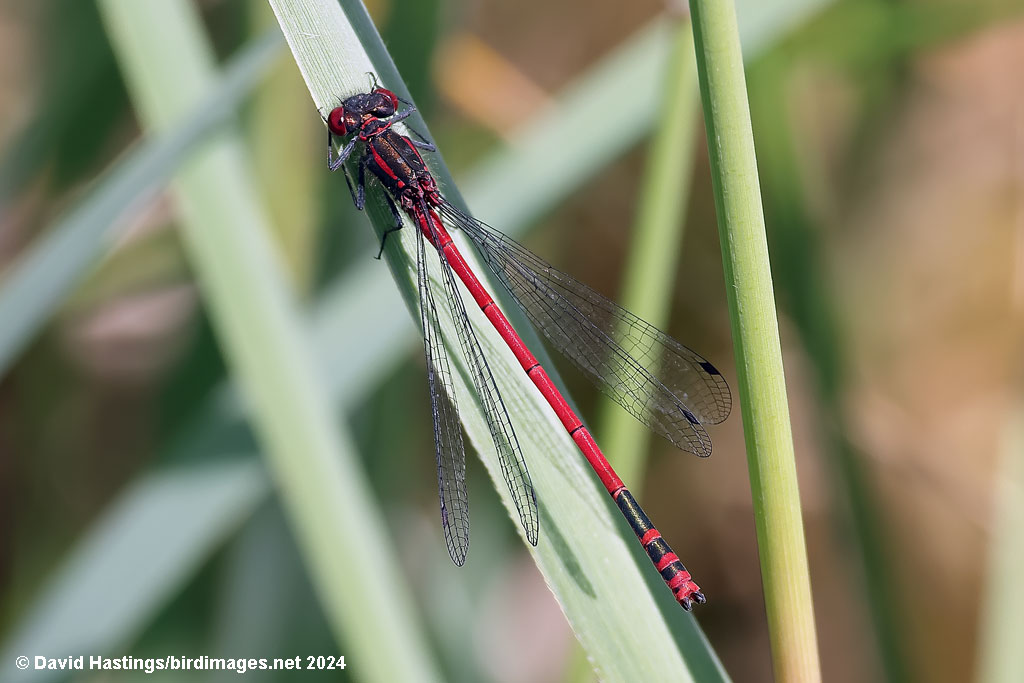 Large Red Damselfly (Pyrrhosoma nymphula). Male. Taken at Parsonage Moor, Oxon., on July 3rd 2024. Male. Taken at Parsonage Moor, Oxon., on July 3rd 2024. (© David Hastings) (1/500th sec at f11. Click image for larger version) 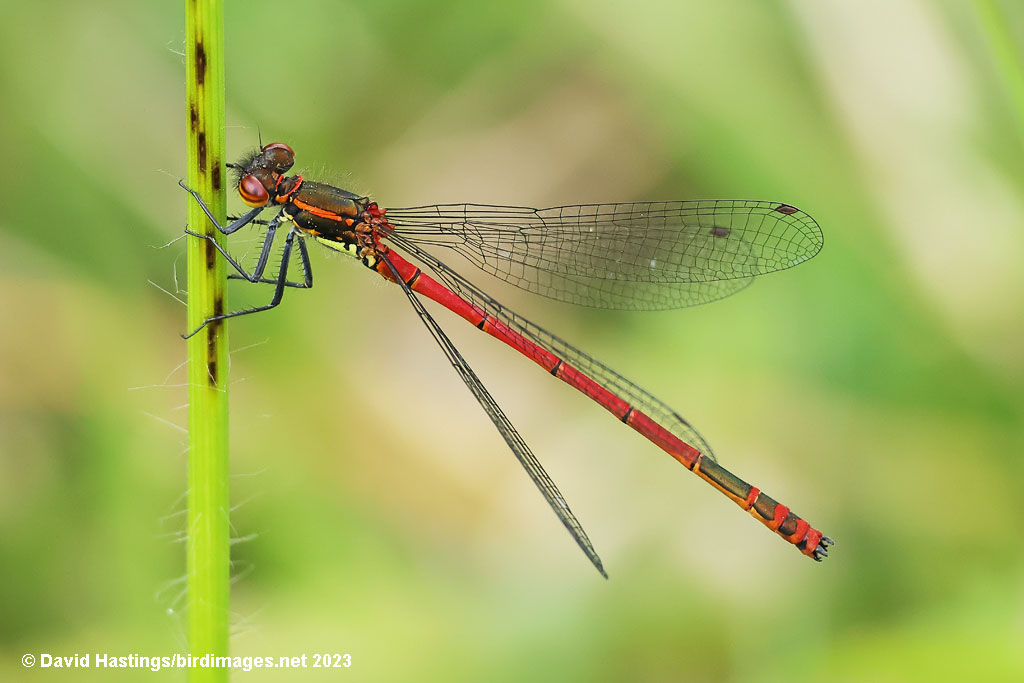 Large Red Damselfly (Pyrrhosoma nymphula). Male. Taken at Rodborough Common, Gloucs, on May 16th 2023. Male. Taken at Rodborough Common, Gloucs, on May 16th 2023. (© David Hastings) (1/640th sec at f10. Click image for larger version) 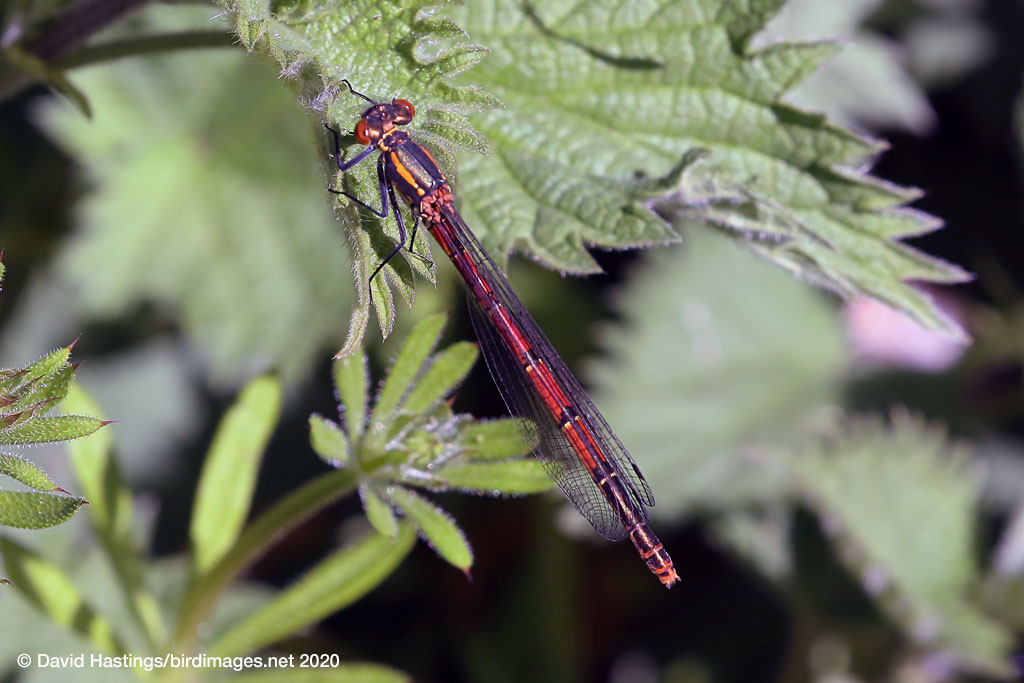 Large Red Damselfly (Pyrrhosoma nymphula). Female of form fulvipes. Taken at Farmoor, Oxon., on May 2nd 2020. Female of form fulvipes. Taken at Farmoor, Oxon., on May 2nd 2020. (© David Hastings) (1/320th sec at f14. Click image for larger version) 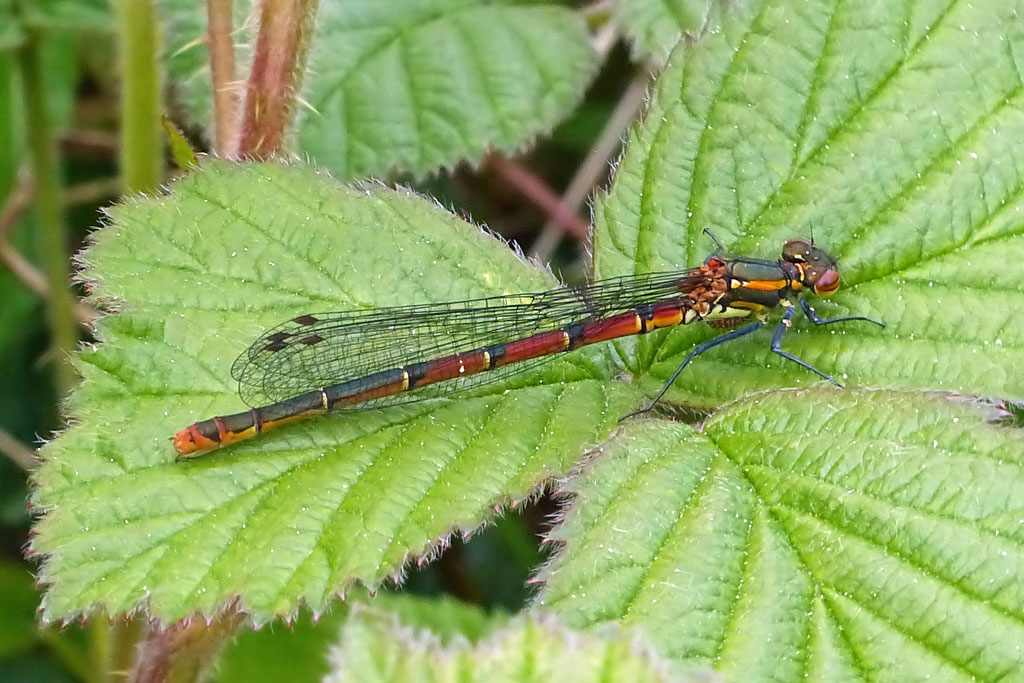 Large Red Damselfly (Pyrrhosoma nymphula). Female of form typica. Taken at Tregaron Bog, Ceredigion, on May 5th 2014. Female of form typica. Taken at Tregaron Bog, Ceredigion, on May 5th 2014. (© David Hastings) (1/160th sec at f7.1. Click image for larger version) 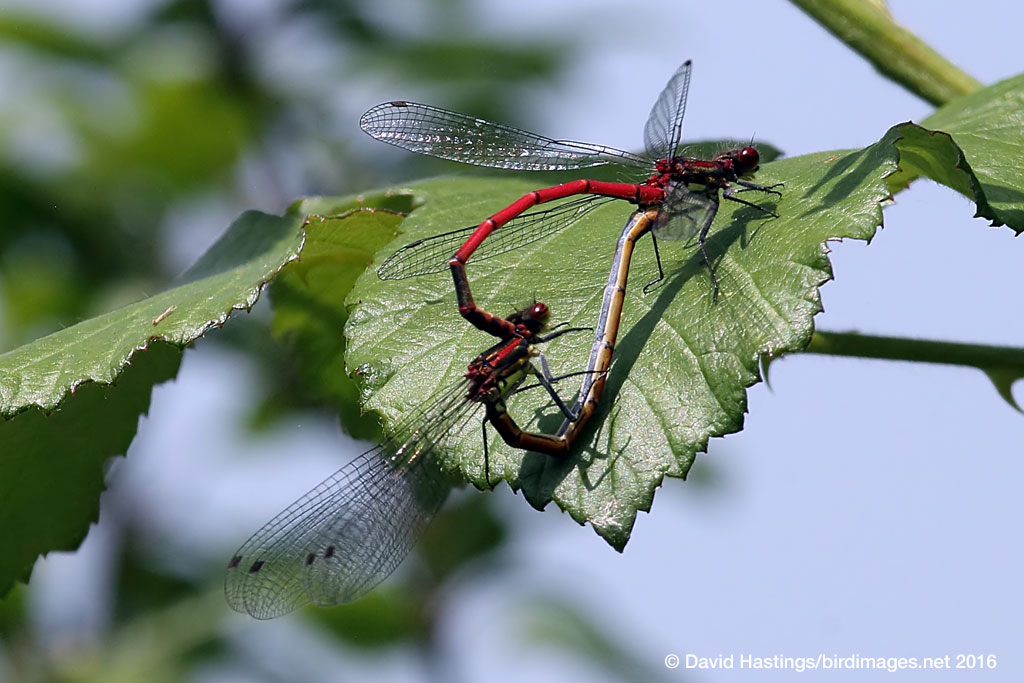 Large Red Damselflies (Pyrrhosoma nymphula). Pair in cop. Taken at Otmoor, Oxon., on June 5th 2016. Pair in cop. Taken at Otmoor, Oxon., on June 5th 2016. (© David Hastings) (1/800th sec at f14. Click image for larger version) Description Wingspan: 38 - 48 mm; Body length: 33 - 36 mm The Large Red Damselfly is often the first damselfly to emerge in the spring. Males have a mostly red body, but the eighth segment is dark and there are two dark bands on the tail. It also has two red antehumeral stripes on the thorax. Teneral males have yellow antehumeral stripes, which change to red when fully mature. Females occur in three colour forms, but all have yellow bands around the abdominal segments. They have red (sometimes yellow) antehumeral stripes. Both sexes have black legs and red eyes. It can be found throughout the British Isles. Large Red Damselflies can be found in most wetland habitats, from acidic moorland bog pools to brackish ditches, but they avoid fast-flowing waters. Eggs are laid in batches of about 350 on submerged vegetation. Larvae live among bottom vegetation and debris, and are unusually territorial. They develop over 1-3, but usually 2 years, and many emerge synchronously on spring mornings. Males emerge slightly earlier and in larger numbers than females, maturing in 12 days (four days earlier than females). The main flight period is May to July. Males defend their territories vigourously. A common and widespread species. Earliest UK sighting: 9th April ; Latest UK sighting: 12th July Sightings | 16-Jun-2025 | : | Whitecross Green Wood, Oxon | (1) | | 30-May-2025 | : | Dry Sandford Pit, Oxon | (12) | | 30-May-2025 | : | Radley Lakes, Oxon | (1) | | 16-May-2025 | : | Radley Lakes, Oxon | (2) | | 16-May-2025 | : | Dry Sandford Pit, Oxon | (6) | | 12-May-2025 | : | Whitecross Green Wood, Oxon | (18) | | 12-May-2025 | : | Otmoor, Oxon | (1) | | 07-May-2025 | : | Nagshead, Gloucs | (1) | | 06-May-2025 | : | Woorgreens, Gloucs | (30+) | | 01-May-2025 | : | Aston, Oxon | (3) | | 30-Apr-2025 | : | Aston, Oxon | (1) | | 29-Apr-2025 | : | Aston Upthorpe Downs, Oxon | (1) | | 28-Apr-2025 | : | Aston, Oxon | (1) |
| | 26-Jun-2024 | : | Whelford Pools, Glos | (1) | | 24-Jun-2024 | : | Whitecross Green Wood, Oxon | (1) | | 21-Jun-2024 | : | Parsonage Moor, Oxon | (1) | | 16-Jun-2024 | : | How Hill NNR, Norfolk | (5) | | 27-May-2024 | : | Whitecross Green Wood, Oxon | (1) | | 18-May-2024 | : | Aston, Oxon | (1) | | 17-May-2024 | : | Dry Sandford Pit, Oxon | (6) | | 08-May-2024 | : | Dry Sandford Pit, Oxon | (2) | | 26-Apr-2024 | : | Dry Sandford Pit, Oxon | (2) |
| | 16-Jun-2023 | : | Whelford Pools, Glos | (1) | | 16-May-2023 | : | Rodborough Common, Glos | (1) | | 16-May-2023 | : | Whelford Pools, Glos | (1) | | 14-May-2023 | : | Aston, Oxon | (1m) | | 04-May-2023 | : | Cors y Llyn NNR, Powys | (3) |
| | 01-Jul-2022 | : | Whitecross Green Wood, Oxon | (1) | | 21-Jun-2022 | : | Wasdale, Cumbria | (2) | | 20-Jun-2022 | : | Foulshaw Moss, Cumbria | (6) | | 17-Jun-2022 | : | Dry Sandford Pit, Oxon | (3) | | 13-Jun-2022 | : | Otmoor, Oxon | (2) | | 07-Jun-2022 | : | Whitecross Green Wood, Oxon | (5) | | 19-May-2022 | : | Aston, Oxon | (3) | | 14-May-2022 | : | Aston, Oxon | (1m) | | 14-May-2022 | : | Dry Sandford Pit, Oxon | (3m,1f) | | 04-May-2022 | : | Cors y Llyn NNR, Powys | (7+) | | 30-Apr-2022 | : | Dry Sandford Pit, Oxon | (3m,1f,2ten) |
| | 05-Jul-2021 | : | Bernwood Forest, Bucks | (1) | | 30-Jun-2021 | : | Dry Sandford Pit, Oxon | (2) | | 15-Jun-2021 | : | Whitecross Green Wood, Oxon | (5) | | 14-Jun-2021 | : | Dry Sandford Pit, Oxon | (3m) | | 07-Jun-2021 | : | Otmoor, Oxon | (2) | | 07-Jun-2021 | : | Whitecross Green Wood, Oxon | (3) | | 05-Jun-2021 | : | Dry Sandford Pit, Oxon | (10) | | 07-May-2021 | : | Dry Sandford Pit, Oxon | (1tenm) |
| | 27-May-2020 | : | Otmoor, Oxon | (3) | | 25-May-2020 | : | Radley Lakes, Oxon | (2) | | 19-May-2020 | : | Otmoor, Oxon | (3) | | 15-May-2020 | : | Farmoor Reservoir, Oxon | (2) | | 14-May-2020 | : | Farmoor Reservoir, Oxon | (1) | | 09-May-2020 | : | Cholsey Marsh, Oxon | (1) | | 05-May-2020 | : | Dry Sandford Pit, Oxon | (7m,2f) | | 02-May-2020 | : | Farmoor Reservoir, Oxon | (4) | | 26-Apr-2020 | : | Farmoor Reservoir, Oxon | (1m) | | 22-Apr-2020 | : | Dry Sandford Pit, Oxon | (5m,2f) | | 20-Apr-2020 | : | Dry Sandford Pit, Oxon | (1m,1ten) |
| | 13-May-2019 | : | Farmoor Reservoir, Oxon | (3) | | 11-May-2019 | : | Abingdon, Oxon | (1) | | 01-May-2019 | : | Farmoor Reservoir, Oxon | (3) | | 30-Apr-2019 | : | Dry Sandford Pit, Oxon | (2) | | 30-Apr-2019 | : | Abingdon, Oxon | (1) |
| | 12-Jul-2018 | : | Parsonage Moor, Oxon | (2) | | 28-Jun-2018 | : | Foulshaw Moss, Cumbria | (8) | | 25-Jun-2018 | : | Eskdale, Cumbria | (6) | | 24-Jun-2018 | : | Wasdale, Cumbria | (1) | | 23-Jun-2018 | : | Meathop Moss, Cumbria | (15+) | | 18-Jun-2018 | : | Otmoor, Oxon | (1) | | 18-Jun-2018 | : | Whitecross Green Wood, Oxon | (2) | | 15-Jun-2018 | : | Dry Sandford Pit, Oxon | (4) | | 11-Jun-2018 | : | Dry Sandford Pit, Oxon | (2) | | 06-Jun-2018 | : | Otmoor, Oxon | (8m) | | 22-May-2018 | : | Dry Sandford Pit, Oxon | (5m,1f) | | 18-May-2018 | : | Radley Lakes, Oxon | (1) | | 14-May-2018 | : | Otmoor, Oxon | (1) | | 11-May-2018 | : | Farmoor Reservoir, Oxon | (1) | | 09-May-2018 | : | Rodborough Common, Glos | (2) | | 05-May-2018 | : | Cors y Llyn NNR, Powys | (17) | | 04-May-2018 | : | Cors y Llyn NNR, Powys | (1) | | 01-May-2018 | : | Otmoor, Oxon | (1) |
| | 01-Jul-2017 | : | Bernwood Forest, Bucks | (1m) | | 14-Jun-2017 | : | Whelford Pools, Glos | (1) | | 30-May-2017 | : | Otmoor, Oxon | (2m) | | 02-May-2017 | : | Dry Sandford Pit, Oxon | (6) |
| | 02-Jul-2016 | : | Foulshaw Moss, Cumbria | (2) | | 28-Jun-2016 | : | Dry Sandford Pit, Oxon | (2m) | | 26-Jun-2016 | : | Otmoor, Oxon | (1) | | 07-Jun-2016 | : | Barton Fields, Abingdon, Oxon | (1) | | 05-Jun-2016 | : | Otmoor, Oxon | (7m,1f) | | 02-Jun-2016 | : | Hawkhill Inclosure, Hants | (1) | | 02-Jun-2016 | : | Hatchet Small Pond, Hants | (1) | | 27-May-2016 | : | Dry Sandford Pit, Oxon | (9) | | 24-May-2016 | : | Dry Sandford Pit, Oxon | (2) | | 15-May-2016 | : | Dry Sandford Pit, Oxon | (4) | | 14-May-2016 | : | Otmoor, Oxon | (3+) | | 05-May-2016 | : | Dry Sandford Pit, Oxon | (1) | | 30-Apr-2016 | : | Otmoor, Oxon | (1) |
| | 21-Jun-2015 | : | Whitecross Green Wood, Oxon | (1m) | | 21-Jun-2015 | : | Otmoor, Oxon | (1m) | | 06-Jun-2015 | : | Dry Sandford Pit, Oxon | (5m) | | 01-Jun-2015 | : | Otmoor, Oxon | (3) | | 17-May-2015 | : | Bentley Wood, Wilts | (3) | | 12-May-2015 | : | Abingdon, Oxon | (1) | | 10-May-2015 | : | Otmoor, Oxon | (2) | | 09-May-2015 | : | Farmoor Reservoir, Oxon | (1) | | 30-Apr-2015 | : | Arne, Dorset | (3) | | 27-Apr-2015 | : | Otmoor, Oxon | (3 ten) |
| | 28-Jun-2014 | : | Dry Sandford Pit, Oxon | (1) | | 18-Jun-2014 | : | nr Mirkovo, Bulgaria | | | 14-Jun-2014 | : | Dry Sandford Pit, Oxon | (2m) | | 08-Jun-2014 | : | Dry Sandford Pit, Oxon | (3) | | 08-Jun-2014 | : | Parsonage Moor, Oxon | (6) | | 07-Jun-2014 | : | Stanford Dingley, Berks | (1) | | 01-Jun-2014 | : | Dry Sandford Pit, Oxon | (3) | | 25-May-2014 | : | Otmoor, Oxon | (4m,1f) | | 17-May-2014 | : | Bentley Wood, Wilts | (5+) | | 17-May-2014 | : | Dry Sandford Pit, Oxon | (2) | | 05-May-2014 | : | Tregaron Bog, Ceredigion | (1) | | 26-Apr-2014 | : | Whelford Pools, Glos | (1) | | 17-Apr-2014 | : | Otmoor, Oxon | (1) |
| | 06-Jul-2013 | : | Paices's Wood, Berks | (2) | | 30-Jun-2013 | : | Bernwood Forest, Bucks | (1) | | 29-Jun-2013 | : | Dry Sandford Pit, Oxon | (3m) | | 25-Jun-2013 | : | Catfield Fen, Norfolk | (4) | | 22-Jun-2013 | : | Otmoor, Oxon | (6m) | | 15-Jun-2013 | : | Parsonage Moor, Oxon | (2) | | 08-Jun-2013 | : | Dry Sandford Pit, Oxon | (18+) | | 27-May-2013 | : | Dry Sandford Pit, Oxon | (c.20) | | 25-May-2013 | : | Dry Sandford Pit, Oxon | (1) | | 25-May-2013 | : | Otmoor, Oxon | (4) | | 19-May-2013 | : | Farmoor Reservoir, Oxon | (1) | | 06-May-2013 | : | Farmoor Reservoir, Oxon | (6) | | 06-May-2013 | : | Otmoor, Oxon | (1) |
| | 27-Jun-2012 | : | Dersingham Bog, Norfolk | (5m) | | 24-Jun-2012 | : | Cothill Fen, Oxon | (1m) | | 22-Jun-2012 | : | Bentley Wood, Wilts | (3) | | 17-Jun-2012 | : | Otmoor, Oxon | (2) | | 28-May-2012 | : | Hatchet Small Pond, Hants | (30+) | | 27-May-2012 | : | Dry Sandford Pit, Oxon | (6) | | 26-May-2012 | : | Dry Sandford Pit, Oxon | (1) | | 13-May-2012 | : | Whelford Pools, Glos | (1) | | 12-May-2012 | : | Farmoor Reservoir, Oxon | (6) | | 06-May-2012 | : | Farmoor Reservoir, Oxon | (6) |
| | 21-May-2011 | : | Bentley Wood, Wilts | (20+) | | 15-May-2011 | : | Dry Sandford Pit, Oxon | (6) | | 02-May-2011 | : | Farmoor Reservoir, Oxon | (12) | | 23-Apr-2011 | : | Abingdon, Oxon | (1) | | 22-Apr-2011 | : | Dry Sandford Pit, Oxon | (1) | | 09-Apr-2011 | : | Otmoor, Oxon | (2) |
| | 26-Jun-2010 | : | The Brenne, Loire Valley, France | | | 21-Jun-2010 | : | Dry Sandford Pit, Oxon | | | 13-Jun-2010 | : | Otmoor, Oxon | | | 12-Jun-2010 | : | Dry Sandford Pit, Oxon | | | 06-Jun-2010 | : | Farmoor Reservoir, Oxon | | | 22-May-2010 | : | Dry Sandford Pit, Oxon | | | 21-May-2010 | : | Otmoor, Oxon | | | 20-May-2010 | : | Dry Sandford Pit, Oxon | | | 15-May-2010 | : | Dry Sandford Pit, Oxon | |
| | 03-Jul-2009 | : | Dry Sandford Pit, Oxon | | | 13-Jun-2009 | : | Dry Sandford Pit, Oxon | | | 31-May-2009 | : | Otmoor, Oxon | | | 24-May-2009 | : | Dry Sandford Pit, Oxon | | | 10-May-2009 | : | Dry Sandford Pit, Oxon | |
| |





